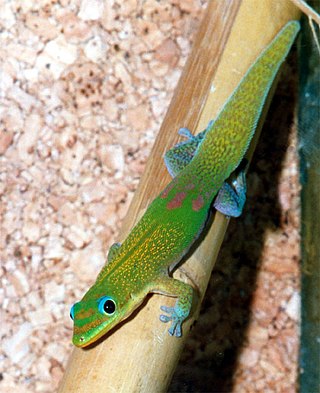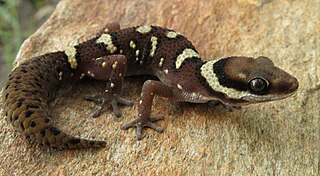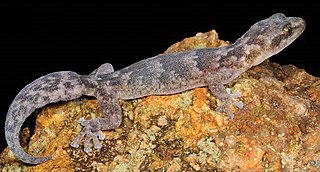
Geckos are small, mostly carnivorous lizards that have a wide distribution, found on every continent except Antarctica. Belonging to the infraorder Gekkota, geckos are found in warm climates throughout the world. They range from 1.6 to 60 centimetres.

Afroedura is a genus of African geckos, lizards in the family Gekkonidae. Member species are collectively known as rock geckos or flat geckos.

Hemidactylus is a genus of the common gecko family, Gekkonidae. It has 195 described species, newfound ones being described every few years. These geckos are found in all the tropical regions of the world, extending into the subtropical parts of Africa and Europe. They excel in colonizing oceanic islands by rafting on flotsam, and are for example found across most of Polynesia. In some archipelagoes, cryptic species complexes are found. Geckos like to live in and out of houses. They have been introduced to Australia.

Pachydactylus is a genus of insectivorous geckos, lizards in the family Gekkonidae. The genus is endemic to Africa, and member species are commonly known as thick-toed geckos. The genus also displays rich speciation, having 58 distinct species identified when compared to other closely related gecko genera like Rhoptropus, most of which have emerged since 35Ma. It has been suggested that the reason for this rich speciation not from adaptive radiation nor nonadaptive radiation, but that the genus represents a clade somewhere between the two drivers of speciation. P. bibronii geckos have been used by NASA as animal models for experimentation.

Coleodactylus is a genus of South American geckos.

Matoatoa is a small genus of geckos, lizards in the family Gekkonidae. The genus is endemic to Madagascar.

Hemidactylus prashadi, also known commonly as the Bombay leaf-toed gecko or Prashad's gecko, is a species of lizard in the family Gekkonidae. The species is endemic to the Western Ghats of India.
Hemidactylus foudaii, also known commonly as the Elba gecko, is a species of lizard in the family Gekkonidae. The species is native to North Africa.

The Eublepharidae are a family of geckos (Gekkota) consisting of 43 described species in 6 genera. They occur in Asia, Africa, North America, and Central America. Eublepharid geckos lack adhesive toepads and, unlike other geckos, have movable eyelids, thus commonly called eyelid geckos. Like other members of Gekkota, the Eublepharidae exhibits tail autotomy due to the fracture planes near their vent. A new tail will then grow in its place, usually lacking the original color and texture. The muscles in the old tail will continue to flex for up to 30 minutes after the drop to distract predators. Leopard geckos and African fat-tailed geckos are popular pet lizards.

Lepidodactylus lugubris, known as the mourning gecko or common smooth-scaled gecko, is a species of lizard, a gecko of the family Gekkonidae.

The Phyllodactylidae are a family of geckos (Gekkota) consisting of 163 species in 10 genera, distributed throughout the New World, North Africa, Europe and the Middle East. The family was first delineated based on a molecular phylogenetic analysis in 2008, and all members possess a unique single codon deletion in the phosducin (PDC) gene. The phyllodactylid genus Bogertia has been recently synonymized with Phyllopezus. The name of the family comes from the leaf shaped fingers.

The Carphodactylidae, informally known as the southern padless geckos, are a family of geckos, lizards in the infraorder Gekkota. The family consists of 34 described species in 7 genera, all of which are endemic to Australia. They belong to the superfamily Pygopodoidea, an ancient group of east Gondwanan geckos now only found in Australasia. Despite their well-developed limbs, molecular phylogenies have demonstrated that Carphodactylidae is the sister group to Pygopodidae, a highly specialized family of legless lizards.

The Sphaerodactylidae are a family of geckos (Gekkota) distributed in North America, Central America, South America, and the Caribbean, as well as in Southern Europe, North Africa, the Middle East, and into Central Asia. The family contains 12 living genera and over 200 living species. The family name comes from the ball shape of their finger joints.

The Diplodactylidae are a family in the suborder Gekkota (geckos), with over 150 species in 25 genera. These geckos occur in Australia, New Zealand, and New Caledonia. Diplodactylids are the most ecologically diverse and widespread family of geckos in both Australia and New Caledonia, and are the only family of geckos found in New Zealand. Three diplodactylid genera have recently been split into multiple new genera.

Gekkonomorpha is a clade of lizards that includes geckos and their closest relatives. Although it was first named in 1900, Gekkonomorpha was not widely used as a formal taxon until it was given a phylogenetic definition in the 1990s. Under this definition, Gekkonomorpha is a stem-based taxon containing the node-based taxon Gekkota, the group that includes the last common ancestor of all living geckos and its descendants. The extent of Gekkonomorpha beyond gekkotans differs between studies. For example, Lee (1998) defined Gekkonomorpha in such a way that it included not only Gekkota but the legless amphisbaenian and dibamid lizards as well. The phylogenetic analysis of Conrad (2008), which did not support a close relationship between geckos and legless lizards, used Gekkonomorpha in a much more restrictive sense so that it included only Gekkota and a few extinct lizards more closely related to Gekkota than to any other living group of lizards. Some of the most recent phylogenetic analyses suggest that the extinct lizards Gobekko and Parviraptor may be stem gekkotans, although other analyses find that Gobekko may instead be within Gekkota and Parviraptor outside Gekkonomorpha.

Amalosia jacovae, also known commonly as the clouded gecko or the clouded velvet gecko, is a species of lizard in the family Diplodactylidae. The species is endemic to Australia.

Bogert's rock gecko is a species of lizard in the family Gekkonidae. The species is native to southern Africa.
Haacke's rock gecko, also known commonly as Haacke's flat gecko, is a species of lizard in the family Gekkonidae. The species is endemic to South Africa.
Vankampen's gecko is a species of lizard in the family Gekkonidae. The species is endemic to New Guinea.

Pygopodoidea is a gecko superfamily and the only taxon in the gekkotan subclade Pygopodomorpha. The clade includes three Australasian families: Diplodactylidae, Carphodactylidae, and Pygopodidae. Traditional gekkotan systematics had considered Diplodactylidae and Carphodactylidae as subfamilies of the family Gekkonidae, but recent molecular work have placed Pygopodidae within Gekkonidae making it paraphyletic. These analyses have shown support of Pygopodidae and Carphodactylidae being sister taxa, with Diplodactylidae occupying a basal position in Pygopodoidea.
















